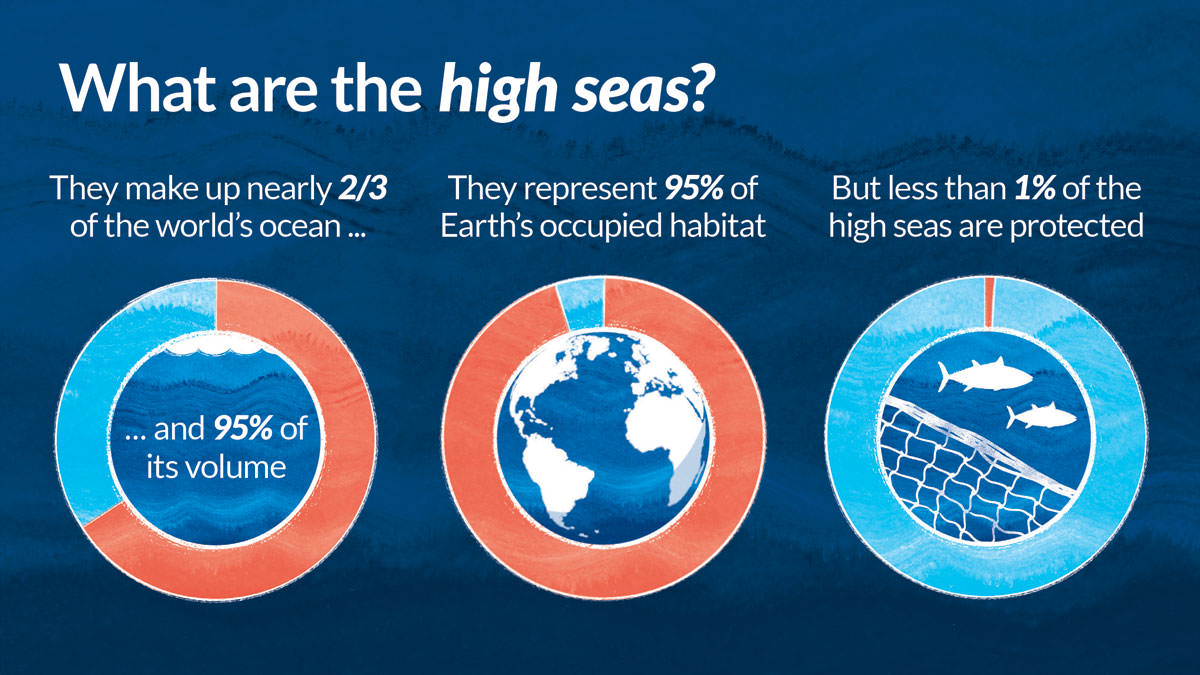Context
-
Negotiations involving 168 countries, including the European Union, to agree on a UN High Seas Treaty for protecting oceans failed.
-
The UN Secretary-General Antonio Guterres had declared an “ocean emergency” at the UN Ocean Conference in Lisbon, Portugal, citing threats to the world’s oceans.
What is the proposed UN High Seas treaty?
- Also referred to as the ‘Paris Agreement for the Ocean’, the treaty to deal with Biodiversity Beyond National Jurisdiction has been under discussion for several years.
- The proposed treaty concerns the ocean existing beyond the Exclusive Economic Zones that lie from the coast of a country to about 200 nautical miles or 370 km into the sea, till where it has special rights for exploration. Waters beyond that are known as open seas or high seas.

Source: Global Fishing Watch - The treaty was to be negotiated under the United Nations Convention on Laws of the Sea (UNCLOS) of 1982 which governs the rights of countries regarding marine resources. As there is no treaty for conserving the health of vast swathes of the earth’s oceans, a UN resolution in 2017 had decided to rectify this while setting 2022 as the deadline.
- The pandemic resulted in many delays, and later, a High Ambition Coalition, which now has more than 100 countries including India, the US, and the UK, came about and put the focus on ‘30×30’ goals – protecting 30% of the ocean by 2030. After the latest deadlock, talks will only resume next year, unless a special session is called.
- Some aspects of negotiations included establishing marine protected areas to put limits on certain activities, environmental impact assessments or clearances for sustainability of works, financial support to countries and sharing other scientific knowledge. The International Union for Conservation of Nature has said binding agreements are needed for this treaty to be effective.
How are the world’s oceans regulated as of now?
- Some treaties, along with the UNCLOS, regulate the conduct of actors on the high seas.
- The UNCLOS led to the establishment of territorial sea boundaries 22 km offshore, deciding the region up to which countries could claim full sovereign territorial rights, as well as the 200 nautical miles EEZ limit.
- It also created the International Seabed Authority and other conflict-resolution mechanisms.
- But a treaty dedicated to protecting ocean health does not exist as of now.
- Conversely, every country has the right to access open seas, resulting in large-scale drilling and trawling operations for catching fish and other animals for commercial purposes.
What are the risks of countries failing to reach an agreement?
- Ninety per cent of global warming is occurring in the ocean, according to the NASA website.
- “The effects of ocean warming include sea level rise due to thermal expansion, coral bleaching, accelerated melting of Earth’s major ice sheets, intensified hurricanes, and changes in ocean health and biochemistry,” it says.
- Excessive fishing has increased manifold over the years, and a third of species such as sharks and rays are at the risk of extinction, according to the World Wildlife Fund.
- Despite acknowledging these threats, members failed to agree on how to deal with these threats.
- Some countries in the Caribbean alleged that richer countries of the Global North did not actively participate until the last few days of the talks.
Reference: IE
Visit Abhiyan PEDIA (One of the Most Followed / Recommended) for UPSC Revisions: Click Here
IAS Abhiyan is now on Telegram: Click on the Below link to Join our Channels to stay Updated
IAS Abhiyan Official: Click Here to Join
For UPSC Mains Value Edition (Facts, Quotes, Best Practices, Case Studies): Click Here to Join
